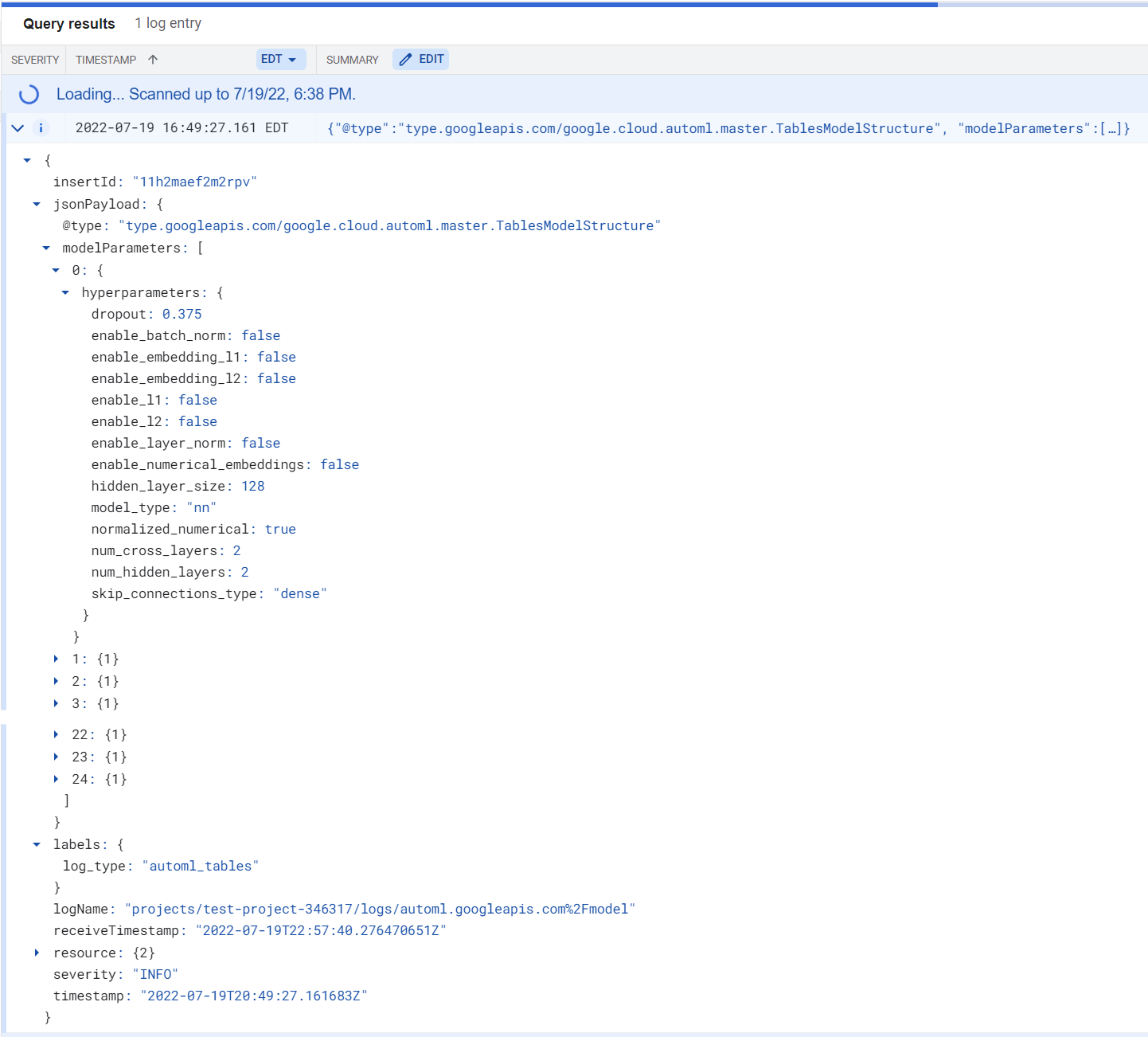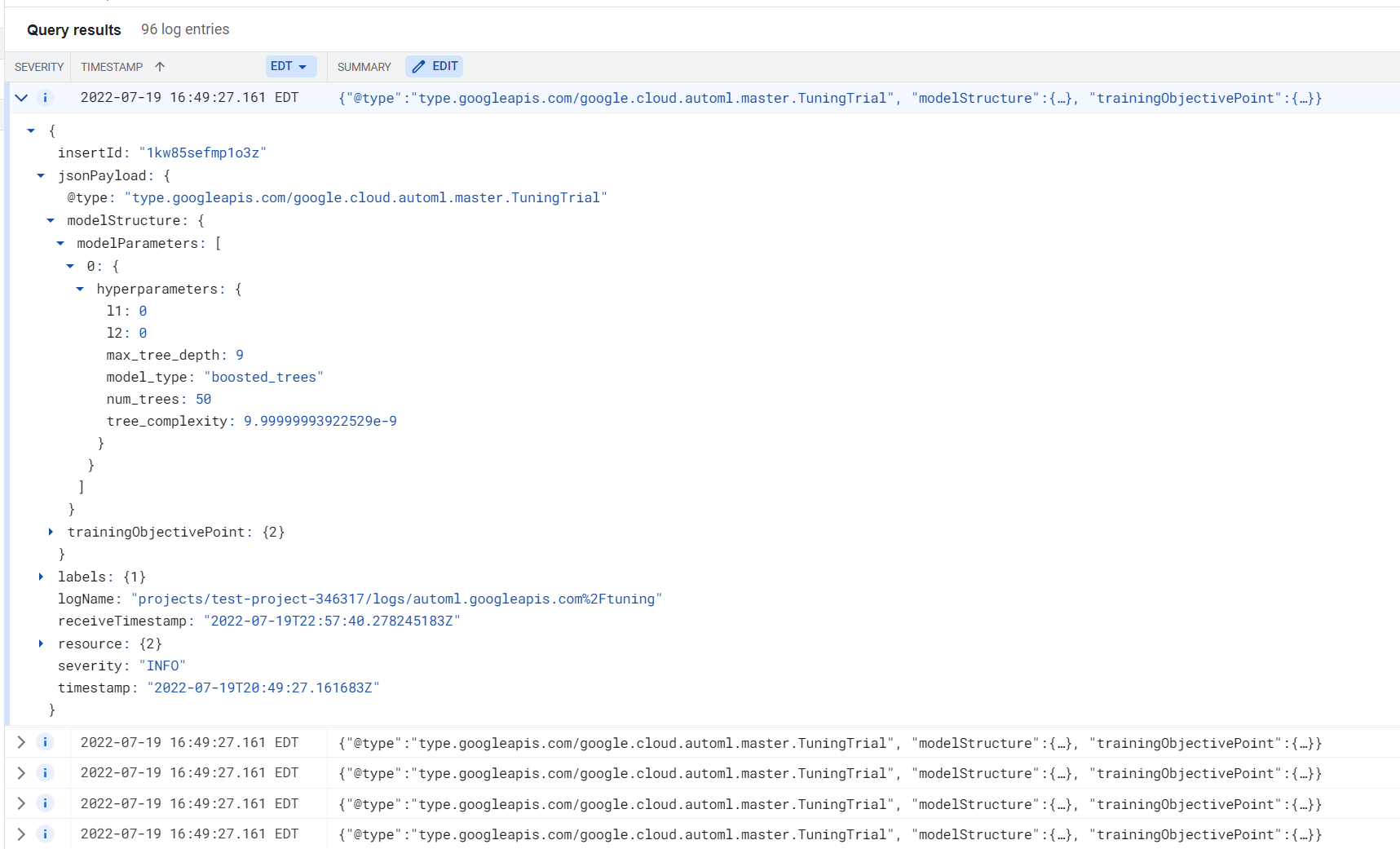Diese Seite enthält Informationen zur Verwendung von Cloud Logging, um Details zu einem Vertex AI-Modell aufzurufen. Mit Logging können Sie Folgendes sehen:
- Die Hyperparameter des endgültigen Modells als Schlüssel/Wert-Paare.
- Die Hyperparameter und Objektwerte, die während des Modelltrainings und der Feinabstimmung verwendet werden, sowie einen Zielwert.
Standardmäßig werden Logs nach 30 Tagen gelöscht.
Dabei werden die folgenden Themen behandelt:
Vorbereitung
Bevor Sie die Hyperparameterlogs für Ihr Modell aufrufen können, müssen Sie es trainieren.
Zum Ausführen dieser Aufgabe benötigen Sie die folgenden Berechtigungen:
logging.logServiceIndexes.listfür das Projektlogging.logServices.listfür das Projekt
Trainingslogs anzeigen
Mit der Google Cloud Console können Sie auf die Hyperparameterlogs des endgültigen Modells und auf die Hyperparameterlogs der Abstimmungstests zugreifen.
Rufen Sie in der Google Cloud Console die Seite Vertex AI-Modelle auf.
Wählen Sie im Drop-down-Menü Region die Region aus, in der sich Ihr Modell befindet.
Wählen Sie Ihr Modell aus der Liste aus.
Wählen Sie die Versionsnummer des Modells aus.
Öffnen Sie den Tab Versionsdetails.
Klicken Sie zum Aufrufen des Hyperparameterlogs des endgültigen Modells in der Zeile Modell-Hyperparameter auf Modell.
Es gibt nur einen Logeintrag. Maximieren Sie die Nutzlast wie unten dargestellt: Weitere Informationen finden Sie unter Logfelder.

Rufen Sie die Zeile Modell-Hyperparameter auf und klicken Sie auf Testversionen, um das Hyperparameterlog der Abstimmungstests aufzurufen.
Für jeden Abstimmungstest gibt es einen Eintrag. Maximieren Sie die Nutzlast wie unten dargestellt. Weitere Informationen finden Sie unter Logfelder.

Logfelder
Aktivitätslogs werden in der Dokumentation zum LogEntry-Typ beschrieben.
Modelllogs für Vertex AI enthalten neben anderen Feldern die folgenden Informationen:
labels: Das Feldlog_typeist aufautoml_tablesgesetzt.jsonPayload: Die spezifischen Details des Logeintrags im JSON-Objektformat. Weitere Informationen finden Sie unter Nutzlastinhalte für das Hyperparameterlog des endgültigen Modells oder Nutzlastinhalte für das Hyperparameterlog eines Abstimmungstests.timestamp: Datum und Uhrzeit der Erstellung des Modells oder der Ausführung des Tests.
Nutzlastinhalte für das Hyperparameterlog des endgültigen Modells
Das Feld jsonPayload für das Hyperparameterlog des endgültigen Modells enthält das Feld modelParameters. Dieses Feld enthält einen Eintrag für jedes Modell, das zum endgültigen Ensemble-Modell beiträgt. Jeder Eintrag hat ein Feld hyperparameters, dessen Inhalt vom Modelltyp abhängt. Weitere Informationen finden Sie unter Liste der Hyperparameter.
Nutzlastinhalte für das Hyperparameterlog eines Abstimmungstests
Das jsonPayload-Feld für das Hyperparameterlog eines Abstimmungstests enthält folgende Felder:
| Feld | Typ | Beschreibung |
|---|---|---|
modelStructure |
JSON |
Eine Beschreibung der Vertex AI-Modellstruktur.
Dieses Feld enthält das Feld |
trainingObjectivePoint |
JSON | Das für das Modelltraining verwendete Optimierungsziel. Dieser Eintrag enthält einen Zeitstempel und einen Zielwert, die zum Zeitpunkt der Aufzeichnung des Logeintrags erstellt werden. |
Liste der Hyperparameter
Die in den Logs angegebenen Hyperparameterdaten unterscheiden sich je nach Modell. In den folgenden Abschnitten werden die Hyperparameter für jeden Modelltyp beschrieben.
Gradient Boosted-Entscheidungsbaummodelle
- Baum-Regularisierung L1
- Baum-Regularisierung L2
- Maximale Strukturtiefe
- Modelltyp:
GBDT - Anzahl der Bäume
- Komplexität des Baums
Neuronale Feed-Forward-Netzwerkmodelle
- Abbruchquote
- BatchNorm aktivieren (
TrueoderFalse) - Einbettung von L1 aktivieren (
TrueoderFalse) - Einbettung von L2 aktivieren (
TrueoderFalse) - L1 aktivieren (
TrueoderFalse) - L2 aktivieren (
TrueoderFalse) - LayerNorm aktivieren (
TrueoderFalse) - Numerische Einbettung aktivieren (
TrueoderFalse) - Größe der ausgeblendeten Ebenen
- Modelltyp:
nn - Numerische Spalte normalisieren (
TrueoderFalse) - Anzahl der Cross-Ebenen
- Anzahl der ausgeblendeten Ebenen
- Typ für Verbindungen überspringen (
dense,disable,concatoderslice_or_padding)
Nächste Schritte
Sobald Sie bereit sind, Vorhersagen mit Ihrem Klassifizierungs- oder Regressionsmodell zu treffen, haben Sie zwei Möglichkeiten:
Sie können auch regelmäßiger Leser eines Blogs oder einer URL
- Modell bewerten
- Allgemeine Informationen zu Cloud Logging lesen
- Sie können Ihre Logs nach BigQuery, Cloud Storage oder Pub/Sub exportieren. Unter Logs an unterstützte Ziele weiterleiten in der Logging-Dokumentation finden Sie Informationen zum Exportieren von Aktivitätslogs.

